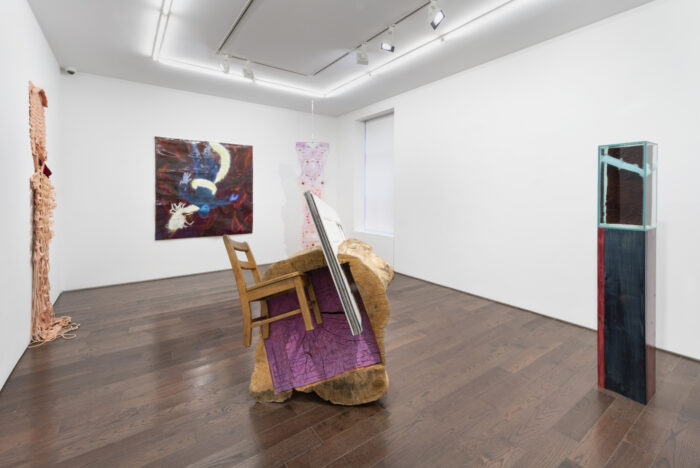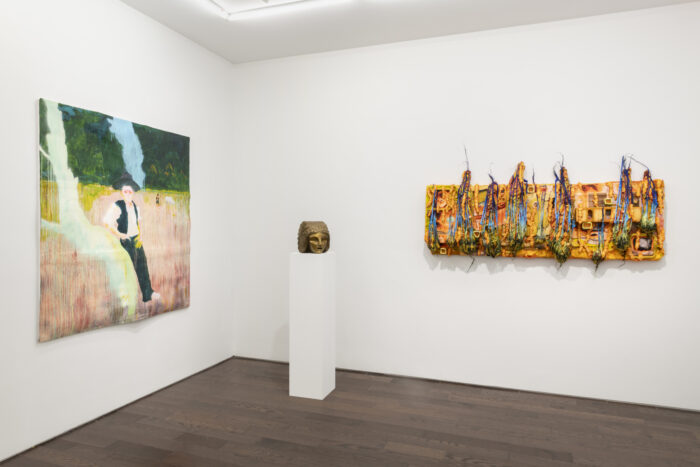




Cult of The Crimson Queen
Curated by Michelle Segre at Ceysson & Bénétière Galler
February 05 – March 14, 2020
Opening on Wednesday, February 05, 6-8 PM
PR: Ceysson & Bénétière is pleased to present Cult of the Crimson Queen, curated by Michelle Segre. Featuring works by Sarah Braman, Amy Brener, Sedrick Chisom, Kari Cholnoky, Joy Curtis, Nikita Gale, Naotaka Hiro, Michael Mahalchick, Sarah Peters, and Jennifer Sirey, this exhibition will be on view from February 5th through March 14th, 2020.
Cult of the Crimson Queen builds upon allusions to cult iconography, ritual practices, and music festivals to propose art as a healing force and palliative to the psychic and material toxicity of the Anthropocene era. The show addresses the connection between mind, body, and environment while also acknowledging the possible ominous implications of collective thinking. Works in the exhibition cultivate a sense of DIY and supernatural intervention, evoking the remnants of a ceremonial action. Found objects, natural materials, as well as seemingly toxic synthetic compounds come together to suggest an ancient-future landscape being rebuilt after a pending ecological collapse.
Each artist in the show viscerally engages the viewer. In Nikita Gales’s sound piece, Keynote Drift, a trumpet imitates the sounds of car horns to create a plaintive, otherworldly raga that channels the breath of the human body while signaling what could be a siren of alarm. Amy Brener’s Flexi-Shields hang like apparitions of a future civilization of self-sufficient Earth-Goddess worshippers, equipped with Q-tips, paperclips and flowers. Likewise, Joy Curtis’ fabric and steel skeletal forms, delicately dyed with natural pigments, employ gravity to hang like flamboyant costumes awaiting use in a ritualized dance. A dance is further evoked in the pigmented bronze of Naotaka Hiro, an artist who literally positions his body inside his medium to capture the action of the self, manipulating his material from within, whether it be a canvas or a mold of silicon, plaster and wax. The result is a work in which the artist appears to be a shaman to his own subconscious; shamanistic and devotional tendencies come together in the works of performance artist and sculptor Michael Mahalchick, whose defaced and collaged rock posters and albums possess a comically unhinged aura further magnified in the assortment of latex face masks that recall the terrifying energy of the throng. Sarah Peters’ mysterious female head summons the sectarians of a secret society while collapsing the linearity of time through her re-imagining of an ancient icon form that feels so precisely of our present era. Magic and the supernatural meld together with the ghosts of a dark and foreboding history in the paintings on paper of Sedrick Chisom, whose work could also be seen as a conjuring of a future planet, where the living walk amongst the spirits of the past. The shockingly flesh-like growths in the vitrines of Jennifer Sirey are actually living bacteria cultivated through a combination of wine and acetobacter, otherwise known, somewhat poetically, as “mother of vinegar.” The tenderly fetishized, acidly colored surfaces of Kari Cholnoky’s paintings, three-dimensional constructions made from an assortment of collaged materials like faux-fur, cotton bandages, and foam feel like a new species come-to-life from a churning stew of chemical waste. Lastly, the artist Sarah Braman employs a formalist approach to the re-purposing of found objects, specifically those pieces of furniture or car or tree that suggest the ritualized acts of every-day life that bring family and friends together or provide solace to the lone individual— eating, reading, sleeping, connecting with nature— the essence of what ultimately saves our sanity
Michelle Segre (b. 1965) lives and works in New York, NY. Segre received her BFA from Cooper Union School of Art, New York and has had solo exhibitions at institutions such as the Cress Gallery of the University of Tennessee in Chattanooga and Antecedents of the Astral Hamster at University Art Museum at the University at Albany, SUNY. Her work has been included in group exhibitions at the Nerman Museum of Contemporary Art in Overland Park, Kansas; the Aldrich Contemporary Art Museum in Ridgefield, CT; and MoMA P.S. 1 Contemporary Art Center in Long Island City, among others. She has been honored with a John Simon Guggenheim Memorial Foundation Fellowship, a Civitella Ranieri Foundation Fellowship, the American Academy of Arts and Letters Award, a New York Foundation for the Arts Fellowship, and the Louis Comfort Tiffany Biennial Award. She is represented by Derek Eller Gallery in New York, NY. In 2019, Segre’s work was included in the publication 100 Sculptors of Tomorrow, by Kurt Beers, published by Thames and Hudson, London.
Writing via press release provided by the gallery








